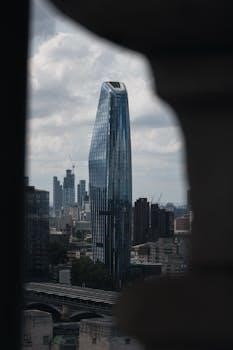free glasses guide for static caravans
Free Glasses Guide for Static Caravans⁚ Understanding and Preventing Condensation

Many people selling static caravans wonder about their value. Unfortunately‚ a publicly available “glasses guide” like those for touring caravans is rare. Factors like condition and location influence valuation. Contacting valuation services for caravans is often the best approach.
Condensation is a prevalent issue in static caravans‚ stemming from the confined space and temperature differences. It’s especially noticeable during colder months when heating systems are in use and ventilation is limited. This moisture manifests primarily on glass surfaces like windows and mirrors‚ but it can also affect walls‚ ceilings‚ and within cupboards.
Understanding the causes and implementing preventive measures is crucial to maintaining a comfortable and healthy environment inside your caravan. Uncontrolled condensation can lead to various problems‚ including mould growth‚ dampness‚ and corrosion‚ ultimately impacting the caravan’s structural integrity and air quality. Proper ventilation‚ insulation upgrades‚ and moisture control strategies are essential for mitigating condensation issues in static caravans. Regularly monitoring and addressing these challenges can help ensure a dry and comfortable living space.
By addressing condensation proactively‚ you can extend the life of your caravan and enjoy a healthier environment during your time spent there.
Why Condensation is a Common Issue
Condensation frequently occurs in static caravans due to several factors. The confined space of a caravan concentrates moisture produced from daily activities like cooking‚ showering‚ and even breathing. When warm‚ moist air comes into contact with cold surfaces‚ such as windows or uninsulated walls‚ condensation forms. Poor ventilation exacerbates this issue‚ preventing the moist air from escaping and allowing it to accumulate.
During colder months‚ the temperature difference between the inside and outside of the caravan is more significant‚ increasing the likelihood of condensation. Closing windows to retain heat further reduces ventilation‚ trapping moisture inside. Additionally‚ many static caravans are not as well-insulated as traditional homes‚ leading to colder surfaces and increased condensation. The combination of these factors makes condensation a common and persistent problem for caravan owners.
Addressing these underlying causes through improved ventilation and insulation is vital for effective condensation control.
The Role of Ventilation in Condensation Control
Ventilation plays a crucial role in preventing condensation in static caravans by removing moist air and replacing it with drier air from the outside. Proper ventilation reduces the humidity levels inside the caravan‚ minimizing the amount of moisture that can condense on cold surfaces. Regularly opening windows and doors‚ even for short periods‚ can significantly improve airflow and reduce condensation buildup.
Ensuring adequate ventilation is especially important after activities that generate a lot of moisture‚ such as cooking or showering. Extractor fans in kitchens and bathrooms can help remove moist air directly at the source. In caravans that are closed up for extended periods‚ leaving windows slightly ajar can prevent moisture accumulation.
Additionally‚ checking and clearing any existing ventilation vents ensures they are functioning correctly. By actively promoting airflow‚ ventilation helps maintain a drier environment inside the caravan‚ greatly reducing the risk of condensation and its associated problems. This simple practice is a vital step in overall moisture management.
Upgrading to Double Glazing for Improved Insulation
Upgrading to double glazing is a highly effective way to improve insulation in static caravans and significantly reduce condensation. Double-glazed windows consist of two panes of glass separated by a layer of air or gas‚ creating a thermal barrier that reduces heat transfer. This improved insulation helps to maintain a more consistent temperature inside the caravan‚ reducing the likelihood of condensation forming on the window surfaces.
Double glazing reduces heat loss during colder months and prevents excessive heat gain during warmer months‚ leading to increased energy efficiency. By keeping the interior glass surface warmer‚ double glazing minimizes the temperature difference between the glass and the air inside‚ thus reducing condensation.
While double glazing can be a more significant investment‚ it offers long-term benefits in terms of comfort‚ energy savings‚ and condensation control. It also increases security and comfort‚ extending the usable season for your static caravan. Ensure that the sealed units come with a manufacturer’s guarantee against internal condensation.

Using Dehumidifiers to Reduce Moisture
Dehumidifiers are a practical solution for reducing moisture levels inside a static caravan‚ helping to prevent condensation. These devices work by drawing in air‚ removing excess moisture‚ and then releasing drier air back into the room. By lowering the humidity‚ dehumidifiers reduce the amount of water vapor available to condense on cold surfaces‚ such as windows and walls.
During colder months‚ when static caravans are often closed up and heated‚ moisture can accumulate from various sources like cooking‚ showering‚ and even breathing. A dehumidifier can effectively counteract this buildup‚ maintaining a drier and more comfortable environment.
Regular use of a dehumidifier‚ especially during periods of high humidity or when the caravan is occupied‚ can significantly reduce the risk of condensation and the associated problems like mold and mildew growth. It’s important to choose a dehumidifier with an appropriate capacity for the size of your caravan and to empty the water collection tank regularly. Some dehumidifiers also come with settings that allow you to control the desired humidity level.
Applying Washing-Up Liquid to Windows
A simple yet effective trick for reducing condensation on static caravan windows involves applying a thin layer of washing-up liquid. This method works by creating a film on the glass surface that prevents water droplets from forming‚ thus reducing condensation.
To apply‚ dab a small amount of washing-up liquid onto a clean cloth. Then‚ gently wipe the entire window surface‚ ensuring an even‚ thin coating. Avoid using too much liquid‚ as this can leave streaks or a sticky residue. The goal is to create a barely perceptible film that disrupts the surface tension of water‚ preventing it from beading up into larger droplets.
This technique is particularly useful in areas prone to condensation‚ such as bathrooms and kitchens‚ where moisture levels tend to be higher. While not a permanent solution‚ applying washing-up liquid can provide temporary relief from condensation‚ keeping your windows clearer and improving visibility. Reapplication may be necessary periodically‚ depending on humidity levels and window usage.
It’s a cost-effective and readily available method that can make a noticeable difference in managing condensation within your static caravan.
Thermal Window Covers and Their Benefits
Thermal window covers are an effective solution for reducing condensation in static caravans by providing an extra layer of insulation. These covers help maintain a more consistent temperature on the window surface‚ minimizing the temperature difference between the glass and the interior air‚ which is a primary cause of condensation.
By acting as an insulator‚ thermal covers keep the window glass warmer‚ reducing the likelihood of moisture forming on the surface. This is especially beneficial during colder months when temperature disparities are greater. These covers come in various materials and designs‚ including reflective films‚ insulated curtains‚ and fitted blinds‚ each offering different levels of insulation and light control.
Beyond condensation control‚ thermal window covers offer several additional benefits. They can help reduce heat loss in winter‚ keeping your caravan warmer and potentially lowering heating costs. In summer‚ they can reflect sunlight‚ preventing excessive heat buildup and maintaining a cooler indoor environment. Furthermore‚ they provide added privacy and can help block out unwanted light‚ creating a more comfortable living space.
Investing in thermal window covers is a practical step towards managing condensation and enhancing the overall comfort and energy efficiency of your static caravan.
Regular Cleaning and Drying of the Caravan

Regular cleaning and thorough drying of your static caravan play a crucial role in preventing condensation and maintaining a healthy living environment. Moisture accumulation from daily activities like cooking‚ showering‚ and even breathing can contribute to condensation issues‚ especially in enclosed spaces.
Cleaning helps remove dirt‚ dust‚ and potential mold spores that can trap moisture and exacerbate condensation problems. Focus on areas prone to dampness‚ such as windowsills‚ corners‚ and bathroom surfaces. After cleaning‚ it’s essential to dry these areas thoroughly with a clean cloth to eliminate any residual moisture.
Pay particular attention to drying surfaces after showering or cooking‚ as these activities generate significant amounts of humidity. Wipe down bathroom walls‚ mirrors‚ and shower doors to prevent water droplets from lingering. In the kitchen‚ ensure that spills are cleaned up promptly and that surfaces are dried after washing dishes or preparing meals.
Additionally‚ consider using a window vacuum to remove excess water from windows and shower units‚ further reducing the chances of condensation forming. By incorporating regular cleaning and drying into your caravan maintenance routine‚ you can effectively minimize moisture levels and create a more comfortable and condensation-free environment.

Addressing Condensation in Corners and Cupboards
Corners and cupboards in static caravans are often prone to condensation due to poor air circulation and temperature variations. These enclosed spaces can trap moisture‚ leading to dampness‚ mold growth‚ and unpleasant odors. Addressing condensation in these areas requires a proactive approach to improve ventilation and reduce moisture levels.
Start by ensuring adequate airflow within cupboards by avoiding overcrowding and leaving some space between items. Consider using breathable storage containers instead of airtight plastic bins to allow air to circulate freely. Regularly open cupboard doors to ventilate the space and prevent moisture buildup.
In corners‚ where air circulation is naturally limited‚ consider using moisture absorbers or dehumidifying crystals to draw out excess moisture. These products can help to reduce humidity levels and prevent condensation from forming. Place them strategically in corners and replace them regularly as needed.
Additionally‚ inspect corners and cupboards regularly for signs of dampness or mold growth. If you detect any issues‚ clean the affected areas with a mold and mildew cleaner and ensure they are thoroughly dried. Improving insulation in these areas can also help to reduce temperature differences and minimize condensation. By addressing condensation in corners and cupboards‚ you can create a healthier and more comfortable living environment in your static caravan.
Professional Valuation Services for Static Caravans
Determining the accurate value of a static caravan can be challenging‚ especially without access to industry-specific valuation guides. Professional valuation services offer expertise and resources to provide reliable assessments based on various factors. These services consider the caravan’s age‚ condition‚ size‚ features‚ and location to determine its market value.
Engaging a professional valuer ensures an unbiased and objective assessment‚ which is crucial for both buyers and sellers. They have extensive knowledge of the static caravan market and can provide insights into current trends and demand.
During the valuation process‚ the valuer will conduct a thorough inspection of the caravan‚ noting any damages‚ repairs‚ or upgrades. They will also consider the park’s location‚ amenities‚ and fees‚ as these can significantly impact the caravan’s value.
A professional valuation report provides a detailed breakdown of the caravan’s worth‚ justifying the assessed value; This report can be used for various purposes‚ such as selling the caravan‚ securing financing‚ or resolving disputes.
By utilizing professional valuation services‚ you can gain confidence in the accuracy of the assessment and make informed decisions regarding your static caravan.
